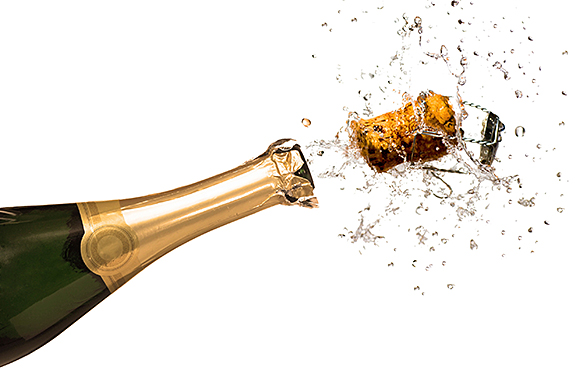Tailgating with Champagne
Nothing says Saturday in Central New York like a Syracuse Football Tailgate. Luckily for this crew, Kathy and her husband have become experts in throwing a pregame bash. What we discovered on Saturday was how many of our fellow tailgaters are also wine lovers.
In anticipation of New Year’s Eve and other upcoming celebrations, we decided to taste Champagne and Cava so of course we selected a tailgate venue. What?? Not really, we ran out of time, so we combined two social events into one and tasted our bubbly under the tailgate tent near the dome. After trying it out of necessity, we recommend a tailgate wine tasting – it was an unexpected and inventive mashup that worked.
Before turning to the tasting, let’s begin with a question, what is champagne? According to Catherine Rickmann of Tasting Table magazine, “Champagne is exclusively made in the French northeast, where crisp climates result in dry wines with a unique terroir.” Rickmann goes on to explain that “Champagne is produced using a technique known as the méthode champenoise, whereby, after initial fermentation, Champagne is blended and bottled with additional sugar and yeast and goes through a second fermentation in the bottle. Champagne must then age for a minimum of 15 months in a winemaker’s cellar before it can be sold (though many age for longer), with vintages aging for three years or more.” The taste of Champagne is often described as light and fruity like a pear or apple with distinct bread like flavor.
While Champagne is French, Cava is, by definition, Spanish and it is produced using the same double fermentation process as Champagne. According to Sara Ventiera writing for Wine Enthusiast Magazine, “the flavor profile and mouthfeel are the most significant contrasts. Champagne’s cooler climate, higher acidity grapes, and signature chalky limestone soil give [champagne] a much more bracing spine of acidity. Whereas Cava is known to be rounder in texture.” Ventiera goes on to point out that some Cavas have a “smokiness that blends with toasty and nutty notes without the bracing acidity of Champagne.” Rickmann notes that cava is “slightly sweeter than Champagne and remains sprightly and acidic when poured. Although similar to Champagne with fresh citrus and pear notes, cava also has a certain savory minerality to it.”
Another significant difference between Cava and Champagne is the cost. Champagne is prohibitively expensive, and Cava is much less expensive. Champagne starts at $45 a bottle whereas Cava starts at $10 or $12. The price makes us think its best to save the Champagne for important celebrations.
Turning to our tasting, we compared Nicolas Feuillatte Reserve Exclusive Brut Champagne with Freixenet Brut Cava.
To recap our novice approach to tasting: none of us is a wine expert but we know what we like and are happy to share our unbiased opinion with you. To keep things consistent, we developed our own unique rating system: pass, glass, bottle, case; you can interpret it as 1, 2, 3, and 4 stars.
Nicolas Feuillatte Reserve Exclusive Brut Champagne (Chouilly, Champagne, France)
Kathy and a few of our other guest tasters enjoyed this Champagne describing it as drinkable with a fresh and mild taste. Carolyn noted the light fruit tastes and Kathy liked the crisp, dry flavor. Several tasters found this a bit too dry with some acidity at the finish.
Winemaker: Pale gold in color, abundance of delicate bubbles. Floral aromas of fruit with subtle predominance of white fruits: pear, apple, almonds and hazelnuts. Fresh opening, smooth, pleasant, and balanced.
Retail Cost: $45 per bottle.
Rating: Buy a BOTTLE
Freixenet Brut Cava (Sant Sadurni d’Anoia, Barcelona, Spain)
One guest taster “didn’t even want to finish her glass of Cava” however most others said they enjoyed the Cava but identified a distinct smokiness. One taster preferred the Cava to the Champagne saying he enjoyed the fruity flavor. Most of our tasters, including Kathy, strongly preferred the Champagne to the Cava. Carolyn also preferred the Champagne but enjoyed the smoky flavor of the Cava.
Winemaker: A well-balanced Cava sparkling wine. The fresh palate of apple, ripe pear and bright citrus flavors combine with a long finish and an exciting touch of ginger.
Retail Cost: $13 per bottle.
Rating: Buy a GLASS
Cheers to all from Kathy, Kate, Pam, and Carolyn.










